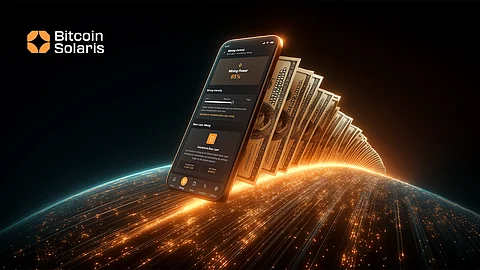

For millions of retail investors, Shiba Inu represents the ultimate underdog story: a low-priced token with the promise of explosive returns. But for all the enthusiasm behind it, the road to $1 is mathematically improbable. With over 500 trillion tokens in circulation, hitting that price point would require a market cap in the hundreds of trillions — far exceeding the total value of all global assets combined. That hasn’t stopped interest, but it has increasingly turned attention to alternatives that offer more realistic — and more immediate — opportunities for wealth generation.
Bitcoin Solaris is quickly becoming one of those alternatives. Instead of hinging value on speculation, Bitcoin Solaris ties its economic model to real participation. It doesn’t rely on hype cycles or burn announcements. It delivers yield through mobile mining, giving users the ability to earn from their phones without needing advanced technical knowledge or specialized hardware.
The Nova App, which has completed closed beta testing and is slated for full rollout, allows anyone with a modern smartphone to mine BTC-S tokens. The system uses idle storage and CPU to support network operations, and rewards are distributed based on real contribution. Users only need a phone, an internet connection, and a few gigabytes of available space.
This is where Bitcoin Solaris diverges sharply from meme coins like SHIB. While Shiba Inu holders wait for price action driven by broader market sentiment, BTC-S participants actively earn — from day one. In early testing, some users reported weekly returns exceeding those of top staking platforms, without locking up tokens or exposing themselves to high-risk farming pools.
Much of the long-term value proposition behind BTC-S lies in its tokenomics. The supply is hard-capped at 21 million — the same structural ceiling that helped drive Bitcoin’s early appreciation. Out of this total, 4.2 million tokens were reserved for presale distribution across transparent phases. The rest — 14 million tokens — are set aside for mobile mining rewards, distributed gradually to avoid flooding the market.
Unlike Shiba Inu, which relies on enormous supply and high turnover to maintain visibility, Bitcoin Solaris is designed for scarcity. There are no hidden team wallets, no private allocations, and no future minting capabilities. What’s been disclosed is final — and that’s built trust with a growing user base.
Bitcoin Solaris’s backend architecture supports its mobile-first approach. The system runs on a dual-layer blockchain, combining Proof-of-Stake and Proof-of-Capacity at the base layer with Proof-of-History and Proof-of-Time on the application layer. The result is a network that validates transactions in under two seconds, handles over 10,000 transactions per second, and consumes 99.95% less energy than traditional mining systems.
This technical design isn’t hypothetical. It’s been audited by Cyberscope and Freshcoins. The project’s leadership has also completed KYC verification, adding a rare layer of transparency during an early-stage rollout.
As Crypto Nitro explains in his latest video, the project is already functioning as a complete system, not a loose set of promises. Mining is ready, demand is active, and supply is finite.
There’s nothing inherently wrong with meme coins. Some have delivered astronomical returns. But they also introduce volatility and fragility. Community-driven growth without utility can reverse as quickly as it rises. Bitcoin Solaris is structured to be the opposite. Its growth is tethered to use — not tweets.
Long-term vision includes Bitcoin-backed tokenization, allowing BTC-S to eventually mirror the value of real Bitcoin on a faster, cheaper infrastructure. That future plan includes smart contract capabilities, cross-chain bridging, and liquid staking — all tied to a transparent reserve mechanism.
While Shiba Inu continues relying on speculative burn mechanics and marketing campaigns, Bitcoin Solaris is quietly building a functional protocol that pays users for being part of the system.
The project is currently in phase 6 of its presale, with BTC-S priced at $6. The next phases will increase pricing incrementally before the token is listed on centralized exchanges, where the initial target price is set at $20. That price isn’t plucked from thin air — it’s based on liquidity benchmarks, demand signals, and onboarding commitments from exchange partners.
Over 11,000 users are already registered for the Nova App rollout. Once it goes live, mining competition will increase, and token availability will tighten. It’s not a last-chance moment — but it is an early one. Those entering now position themselves at the front of the earning curve, with full access to the mining infrastructure and protocol-level rewards.
Shiba Inu may reach new highs. But structurally, it’s a lottery ticket. Bitcoin Solaris is an economy. It’s built around verified contribution, predictable tokenomics, and a secure, mobile-first design. And for users looking to turn digital assets into actual income — not just hold and hope — it’s offering something more stable, more accessible, and far more scalable.
Website: https://bitcoinsolaris.com/
X: https://x.com/BitcoinSolaris
Telegram: https://t.me/Bitcoinsolaris
Join our WhatsApp Channel to get the latest news, exclusives and videos on WhatsApp
_____________
Disclaimer: Analytics Insight does not provide financial advice or guidance on cryptocurrencies and stocks. Also note that the cryptocurrencies mentioned/listed on the website could potentially be scams, i.e. designed to induce you to invest financial resources that may be lost forever and not be recoverable once investments are made. This article is provided for informational purposes and does not constitute investment advice. You are responsible for conducting your own research (DYOR) before making any investments. Read more about the financial risks involved here.
